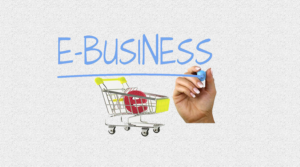E-Commerce Application (iOS, Android Mobile App)
E-commerce is just the process of buying and selling produce by electronic
means such as by mobile applications and the Internet. e-Commerce websites
are built differently, but they all use the same basic functions.

While most people think of e-commerce as business to consumer (B2C), there
are many other types of e-commerce. These include online auction sites,
internet banking, online ticketing and reservations, and business to business
(B2B) transactions.

Recently, the growth of e-commerce has expanded to sales using mobile devices,
which is commonly known as ‘m-commerce’ and is simply a subset of e-
commerce.
Typically, e-Commerce business models can be divided into six major types,
such as:
Business-to-Business (B2B)
Business-to-Consumer (B2C)
Consumer-to-Consumer (C2C)
Consumer-to-Business (C2B)
Business-to-Administration (B2A)
Consumer-to-Administration (C2A)
An e-Commerce website follows these steps:

• A shopper lands on the website. The website shows categories and products
that are loaded in the e-Commerce website database.
• A customer can add items to their cart and create an account. Again, all
information is saved in the database, even if temporarily.
• Once in checkout, the website should now be secure showing a lock symbol and
using an SSL certificate.
• During checkout, the website may use third-party software to get shipping
rates
• When you enter your credit card number the information is passed to a
payment gateway such as PayPal or Authorize.net
• Your order is now completed. The e-Commerce website should not have your
payment information in its database. All sensitive information is stored
with the payment processor.

E-commerce brings convenience for customers as they do not have to leave
home and only need to browse website online, especially for buying the
products which are not sold in nearby shops. It could help customers buy a wider
range of products and save customers’ time. Consumers also gain power through
online shopping. They are able to research products and compare prices among
retailers. Also, online shopping often provides sales promotion or discounts
code, thus it is more price effective for customers. Moreover, e-commerce
provides products’ detailed information; even the in-store staff cannot offer
such a detailed explanation. Customers can also review and track the order history
online.
E-commerce technologies cut transaction costs by allowing both manufacturers
and consumers to skip through the intermediaries. This is achieved through by
extending the search area best price deals and by group purchase. The success
of e-commerce in urban and regional levels depend on how the local firms and
consumers have adapted to e-commerce.
